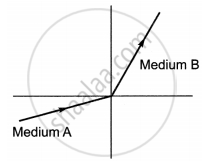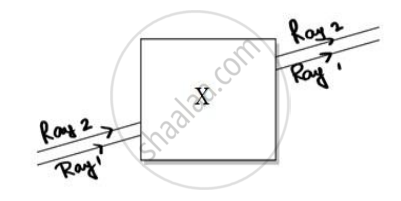Advertisements
Advertisements
प्रश्न
If in a medium, the speed of light is 1.5 × 108 m/s how much will the absolute refractive index of that medium be?
Solve the example.
If the speed of light in a medium is 1.5 × 108 m/s, what is the absolute refractive index of the medium?
उत्तर १
Absolute refractive index of a medium μ = `"Speed of light in vaccum"/ "Speed of light in the medium"`
⇒ μ = `(3 xx 10^8)/(1.5 xx 10^8) = 2`
उत्तर २
Given: Speed of light in medium (v2) = 1.5 × 108 m/s,
velocity of light in vacuum (v1) = 3 × 108 m/s
To find: Absolute refractive index (n)
Formula: n = `"v"_1/"v"_2`
Calculation: From the formula,
n = `(3 xx 10^8)/(1.5 xx 10^8)` = 2
The absolute refractive index of the medium is 2.
APPEARS IN
संबंधित प्रश्न
How refraction of light is related to refractive index?
If the refractive index of glass for light going from air to glass is 3/2, find the refractive index of air for light going from glass to air.
Find out, from Table, the medium having highest optical density. Also find the medium with lowest optical density.
| Material medium | Refractive index | Material medium | Refractive index |
| Air | 1.0003 | Canada Balsam | 1.53 |
| Ice | 1.31 | – | – |
| Water | 1.33 | Rock salt | 1.54 |
| Alcohol | 1.36 | – | – |
| Kerosene | 1.44 | Carbon disulphide | 1.63 |
| Fused quartz | 1.46 | Dense flint glass | 1.65 |
| Turpentine oil | 1.47 | Ruby | 1.71 |
| Benzene | 1.50 | Sapphire | 1.77 |
| Crown glass | 1.52 | Diamond | .42 |
Which of the following diagrams shows the ray of light refracted correctly?
What name is given to the ratio of sine of angle of incidence to the sine of angle of refraction?
Which has higher refraction index : water of glass?
How is the refractive index of a material related to the speed of light in it?
Fill in the following blank with a suitable word:
When a ray of light goes from air into a clear material, you see the ray bend. How much the ray bends is determined by the ............... of the material.
Give three examples of materials that refract light rays. What happens to the speed of light rays when they enter these materials?
The speed of light in vacuum and in two different glasses is given in the table below:
| Medium | Speed of light |
| Vacuum | 3.00 × 108 m/s |
| Flint glass | 1.86 × 108 m/s |
| Crown glass | 1.97 × 108 m/s |
(a) Calculate the absolute refractive indexes of flint glass and crown glass.
(b) Calculate the relative refractive index for light going from crown glass to flint glass.
The speed of light in air is 3 × 108 m/s. In medium X its speed is 2 × 108 m/s and in medium Y the speed of light is 2.5 × 108 m/s Calculate:
(a) air nx
(b) air nY
(c) x nY
Light travels through air at 300 million ms−1. On entering water it slows down to 225 million ms−1. Calculate the refractive index of water.
The refractive indices of four substance P, Q, R and S are 1.50, 1.36, 1.77 and 1.31 respectively. The speed of light is the maximum in the substance:
(a) P
(b) Q
(c) R
(d) S
Refractive indices of water, sulphuric acid, glass and carbon disulphide are 1.33, 1.43, 1.53 and 1.63 respectively. the light travels slowest in:
(a) sulphuric acid
(b) glass
(c) water
(d) carbon disulphide
The following table gives the refractive indices of a few media:
| 1 | 2 | 3 | 4 | 5 | |
| Medium | Water | Crown glass | Rock salt | Ruby | Diamond |
| Refractive index | 1.33 | 1.52 | 1.54 | 1.71 | 2.42 |
Use this table to give an example of:
(i) a medium pair so that light speeds up when it goes from one of these medium to another.
(ii) a medium pair so that light slows down when it goes from one of these medium to another.
Refractive indices of four media A, B, C and D are given below:
| Medium | Refractive index |
| A | 1.33 |
| B | 1.44 |
| C | 1.52 |
| D | 1.65 |
In which of these four media is the speed of light (i) maximum, and (ii) minimum?
State Snell’s law of refraction of light. Write an expression to relate refractive index of a medium with speed of light in vacuum.
The refractive index of a medium ‘a’ with respect to medium ‘b’ is 2/3 and the refractive index of medium ‘b’ with respect to medium ‘c’ is 4/3. Find the refractive index of medium ‘c’ with respect to medium ‘a’.
State the law of refraction of light that defines the refractive index of a medium with respect to the other. Express it mathematically. How is refractive index of any medium 'A' with respect to a medium 'B' related to the speed of propagation of light in two media A and B? State the name of this constant when one medium is vacuum or air.
The refractive indices of glass and water with respect to vacuum are 3/2 and 4/3 respectively. If the speed of light in glass is 2 × 108m/s, find the speed of light in (i) vacuum, (ii) water.
Prove the statement.
If the angle of incidence and angle of emergence of a light ray falling on a glass slab are i and e respectively, prove that, i = e.
The velocity of light in a medium is 1.5 x 188 m/s. What is the refractive index of the medium with respect to air, if the velocity in the air is 3 x 108 m/s?
n = _______. This law is also called as Snell’s law.
If the refractive index of air with respect to glass is 2/3. What is the refractive index of glass with respect to air?
2n1 : Refractive index of medium 2 with respect to medium 1 : : 1n2 : _______
Solve the following example.
Speed in first medium, v1 = 3 × 108 m/s
Speed in second medium, v2 = 2 × 108 m/s
Then 2n1 = ?
Define the refractive index of a medium.
A light ray enters from medium A to medium B as shown in figure. The refractive index of medium B relative to A will be ______.

Noor, a young student, was trying to demonstrate some properties of light in her Science project work. She kept ‘X’ inside the box (as shown in the figure) and with the help of a laser pointer made light rays pass through the holes on one side of the box. She had a small butter-paper screen to see the spots of light being cast as they emerged.

She measured the angles of incidence for both the rays on the left side of the box to be 48.60. She knew the refractive index of the material ‘X’ inside the box was 1.5. What will be the approximate value of angle of refraction?
(use the value: sin 48.6° ≈ 0.75)
Noor, a young student, was trying to demonstrate some properties of light in her Science project work. She kept ‘X’ inside the box (as shown in the figure) and with the help of a laser pointer made light rays pass through the holes on one side of the box. She had a small butter-paper screen to see the spots of light being cast as they emerged.

If the object inside the box was made of a material with a refractive index less than 1.5 then the ______.
Refractive index of diamond with respect to glass is 1.6 and absolute refractive index of glass is 1.5. Find out the absolute refractive index of diamond.
Match the Columns:
| Column ‘A’ | Column ‘B’ |
| Refractive index of water | (a) 1.31 |
| (b) 1.36 | |
| (c) 1.33 |
What happens when a light ray passes from a rarer medium to a denser medium?
The refractive index of glass with respect to air is `5/4` and the refractive index of water with respect to air is `4/3`. Then what will be the refractive index of glass with respect to water?
A light ray enters from medium A to medium B as shown in the figure.
Which one of the two media is denser w.r.t. other medium? Justify your answer.
| The ability of medium to refract light is expressed in terms of its optical density. Optical density has a definite connotation. It is not the same as mass density. On comparing two media, the one with the large refractive index is optically denser medium than the other. The other medium with a lower refractive index is optically rarer. Also the speed of light through a given medium is inversely proportional to its optical density. |
- Determine the speed of light in diamond if the refractive index of diamond with respect to vacuum is 2.42. Speed of light in vacuum is 3 × 108 m/s.
- Refractive indices of glass, water and carbon disulphide are 1.5, 1.33 and 1.62 respectively. If a ray of light is incident in these media at the same angle (say θ), then write the increasing order of the angle of refraction in these media.
- (A) The speed of light in glass is 2 × 108 m/s and is water is 2.25 × 108 m/s.
(a) Which one of the two optically denser and why?
(b) A ray of light is incident normally at the water glass interface when it enters a thick glass container filled with water. What will happen to the path of the ray after entering the glass? Give reason.
OR
(B) The absolute refractive indices of glass and water are 4/3 and 3/2, respectively. If the speed of light in glass is 2 × 108 m/s, calculate the speed of light in (i) vacuum (ii) water.
Absolute refractive indices of glass and water are `3/2 and 4/3` respectively. If the speed of light in glass is 2 × 108 m/s, the speed of light in water is ______.
